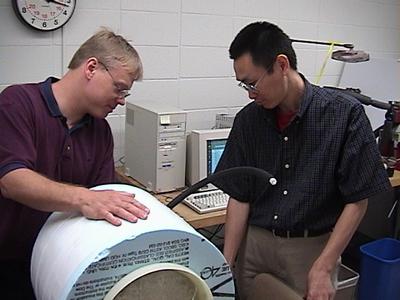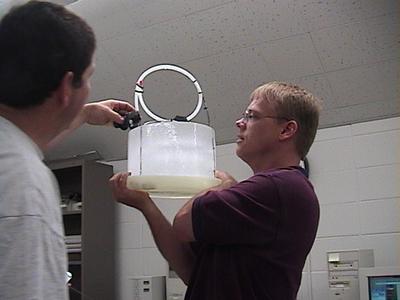
|
|
15 June, 2002
My brother got married in Bethany Beach, Delaware on June 15th, so
Gabriella & I wrapped up my 2 little boys and spent a week at the shore !
Serendipitously, this wasn't too far from the University of Delaware, in
Newark (Delaware, not New Jersey), where the Bartol Institute resides.
http://www.bartol.udel.edu/
Bartol is a major partner in the cosmic ray research taking place at
the South Pole. And Glenn Spiczak, from the University of Wisconsin at River
Falls, planned to be at Bartol in June, so I took a "day off" from vacation
and drove up to Newark.
I met a number of researchers who were involved in the SPASE project : a
surface air shower experiment remarkably similar to WALTA, the school-based
detector network we're building in Seattle.
Here's an introductory paragraph about the SPASE array :
SPASE is a large-area air shower array established at the geographic South
Pole for the detection of cosmic rays with primary energies above 50 TeV. At
these energies, the flux of events is too low to measure on considerably
smaller short duration balloon flight experiments or more expensive
satellite experiments. The array is situated on the Antarctic Plateau near
the U.S. Amundsen-Scott South Pole Station. The unique advantages of this
location are the very high altitude (~10,000 ft) which minimizes the
atmospheric overburden, the circumpolar nature of potential astrophysical
sources, all of which remain at a constant zenith angle, and the existence
of the world's largest muon and neutrino telescope, AMANDA (the Antarctic
Muon And Neutrino Detector Array), below the array. SPASE is supported by
the Office of Polar Programs of the National Science Foundation.
Glen introduced me to a number of the very friendly folks around Tom
Gaisser, Xinhua Bai, and Serap Tilav, some of whom I may see at the Pole. We
looked at some of the SPASE detectors, and talked about some of the projects
I might be assigned to work on at the Pole.
But we spent the best part of the morning working with Bai on a
freezing experiment. In order for the ICETOP (a new array being prototyped)
detectors to work, about 1,000 gallons of water needs to be frozen crystal
clear. This turns out to be very problematic. Bai was working on a method of
cooling a 10-gallon tank of water from the inside out, and we helped him
remove the ice from the tank and criticize it.
I tried to be helpful and suggest everything I knew about making clear
ice : slow dripping and quick freezing, like an icicle. They of course had
been through that and 53 other ideas. Not an easy problem to solve !
We broke for lunch, and over lunch, talked about travel dates (still
very vague) and projects (equally hypothetical). A number of Bartol folks
have been to the Pole 5 or more times, and we talked about the excitement
and romance of the first trip, contrasted with the distinct un-pleasure of
the 5th trip !
Later in the week, I had the opportunity to take my family to the very
elegant Hotel DuPont in Wilmington, De. They do a FABULOUS Sunday brunch,
and the main table is made very elegant by a big sculpture of clear ice in
the shape of porpoises ! I used to go there from time to time when I lived
on the East Coast, and was reminded to go by all the talk about clear ice.
At Bartol, I mentioned this to Glenn. Of course, he'd already been in
contact with the company : they do a very rapid freeze using glycol
circulation, impossible to do at the Pole.

Glenn and Bai examine a 10-gallon tank of water and ice. They are developing a method to freeze a 1,000 gallon tank of clear ice at the South Pole. Eventually, many of these tanks will form a cosmic ray detector array called ICETOP.

Glenn examines the new block of ice. It's quite disappointing, because it's obviously a long way from clear. In this experiment, they carefully degassed the water that was used, and cooled it from the inside out with an elaborate cooling system, and yet, no luck. It seems like a trivial thing, to freeze water into clear ice at the South Pole, yet it's turning out to be problematic. ICETOP will detect the very faint light, called Cerenkov light, made by very high energy parcticles passing through the ice in the tank. If the ice isn't clear, the light won't travel to the top of the tank, where a light-gathering Photomultiplier Tube will collect it and signal the computer.
Contact the TEA in the field at
.
If you cannot connect through your browser, copy the
TEA's e-mail address in the "To:" line of
your favorite e-mail package.
|
